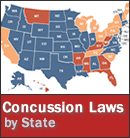A bill introduced in the Montana House of Representatives on March 30 seeks to determine how effective the state’s youth-concussion law has been over the past two years.
In April 2013, the state enacted the “Dylan Steigers Protection of Youth Athletes Act,” which requires all three of the major components of the so-called “ideal” youth-concussion law. Student-athletes and parents must sign and return a concussion-information form before being allowed to participate in athletics; any student-athlete suspected of a concussion must be removed from play immediately; and student-athletes removed from play due to a concussion must receive written clearance from a licensed health-care provider before returning to play. Additionally, the law requires all coaches, athletic trainers, and officials to complete a concussion training session annually.
Two years later, Rep. Gordon Pierson, the author of the new bill, would like to gauge how well school districts around the state are following such rules. The study would investigate how many youth-athletes have been removed from participation after being suspected of a concussion, examine districts’ policies to make sure they align with the state’s law, and determine the effectiveness of the training course for coaches, athletic trainers, and officials.
Additionally, if passed through the state legislature and signed into law, the study would investigate “emerging technologies to evaluate brain injuries in student-athletes, including technologies to evaluate a student-athlete’s ability to return to participation” and compare districts’ policies to the latest information about concussions and sports-related brain injuries.

If the committee conducting the study finds inconsistencies among implementation, it would “investigate ways” to address such concerns, including “statutory changes; requiring the use of specific protocols and evaluation tools; and seeking resources for districts not able to implement policies consistent with current best practices,” among other solutions. The findings would be presented to the state legislature no later than Sept. 15, 2016.
With all 50 states now having youth-concussion laws on the books, this is the next logical step for legislatures to take. Given how new the field of concussion research is, and how much new information continues to surface, legislatures are wise not to simply stop at enacting a statewide youth-concussion law. Though such legislation led to a massive increase in medical treatment for concussions in recent years, according to a study published online in .